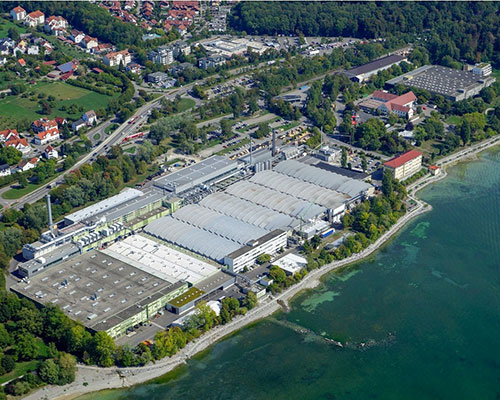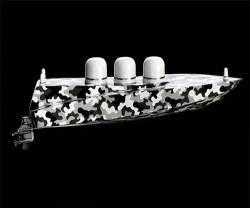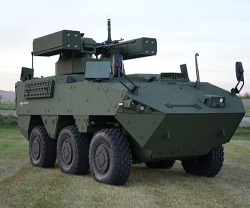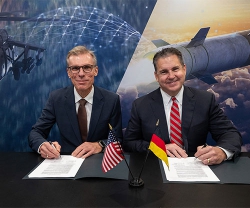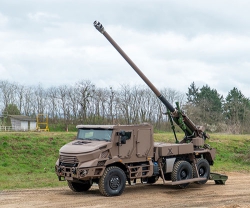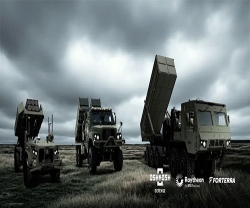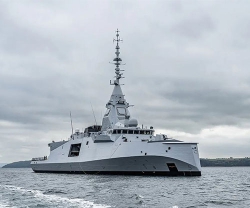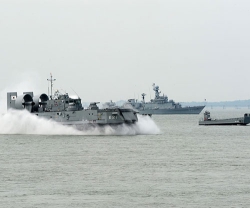Paradoxically, the best of marine engineering in Germany is to be found in regions that are landlocked. Around three-quarters of the value-added on a German-built ship is generated by manufacturers based inland, far away from the sea coast.
That explains why the German government has, for the first time, chosen a non-coastal location as the venue for its National Maritime Conference, which this year is being held on 22 and 23 May in the city of Friedrichshafen on Lake Constance.
Power Systems is a Rolls-Royce business division and with its core brand MTU a prominent example of a shipbuilding supplier based inland. Some 30% of its revenue is derived from marine engines, marine propulsion systems, ship automation systems and services for yachts, ferries (also high-speed), supply ships, and governmental vessels. In 2018 alone, it generated sales to the order of 1.2 billion Euros in marine applications. That makes Rolls-Royce Power Systems the largest supplier to the German maritime industry.
The maritime industry’s suppliers also significantly influence maritime trends, as Andreas Schell, President and CEO of Rolls-Royce Power Systems, points out: “We’re very aware of our defining role. Our current corporate strategy is named Power Systems 2030 and is all about our evolution from straightforward engine-maker to system solutions provider. Our green and high-tech program is part of this strategy, as is our strong focus on electrification, hybridization and digitalization - all of which is in perfect harmony with the ‘global, smart, green’ themes of the National Maritime Conference. Also meant here is the energy turnaround in the maritime industry, which, as Schell went on to emphasize, “We're not just tagging along with, but driving and shaping.”
Green & High-Tech Program
Nothing less than the decarbonization of the drive is the aim of the Green and High-Tech program underway at Rolls-Royce Power Systems. “We want to keep lowering C02 emissions from our drive and propulsion systems to make them as climate-neutral as possible,” says Dr Daniel Chatterjee who leads the Green and High-Tech program. Development engineers at the company have already gone a long way to reducing the output of pollutants such as particulates and nitric oxide by optimizing diesel fuel combustion and refining filter and catalytic convertor technology for diesel engines.
At the same time, MTU’s very first mobile gas engines for marine applications will shortly be going into service on Lake Constance and in the Wadden Sea zone of the North Sea. These boast tangible benefits: The mobile MTU gas engine is already well below the current emission guideline limits (IMO III) without exhaust gas aftertreatment – for example, particulate mass is below the verification limit. It does not emit any sulphur oxides and only small amounts of nitrous oxides.
Hybrids Drive Systems, Digitalization and Alternative Fuels
“New technology for reducing the greenhouse gas CO2 is about to be launched,” says Dr. Martin Teigeler, Development Chief at Rolls-Royce Power Systems. MTU’s hybrid propulsion system for yachts and commercial vessels is scheduled to go into service in a yacht in 2020. The system combines diesel engines with electric motors and batteries. Digital technology for capturing, transmitting and analyzing operating data is also deployed to make marine propulsion as fuel-economic and eco-friendly as possible. And the fuel does not necessarily have to be of fossil origin. Rolls-Royce Power Systems is one of several partners working on Methquest, a flagship project also supported by the German Ministry of Economic Affairs & Energy. Technologies are to be developed and analysed that will enable methane-based fuels from renewables to be used in mobile and stationary applications and subsequently launched on the market.
“If we manage to achieve this with reasonable effort and expense, we will have taken a major step forward towards making the climate-neutral drive a reality. Another idea being floated is the use of fuel cells for marine propulsion,” Teigeler added.
Future as Solutions Provider
The internal combustion engine – be it diesel or gas-powered – will retain its prominence. At the same time however, myriad new possibilities – from battery technology to alternative fuels – are coming into play and opening the field for engineers to build more eco-friendly, efficient drive and propulsion systems. In doing so, they perform the role of solutions provider by meeting all the customer's needs.
Marine Market as Strategic Pillar
The maritime economy represents a major market for MTU engines. “Next to the stationary power generation systems that we deliver, another strategic pillar of our business are products and services for marine applications,”said Andreas Schell, CEO Rolls-Royce Power Systems that is headquartered in Friedrichshafen on Lake Constance. Nearly all marine engines built by MTU, the core brand of Rolls-Royce Power Systems, are manufactured here and supplied to customers across the globe. 90% of marine application products are exported directly or indirectly.
High-Speed Engines Capable of Over 1000 rpm
Capable of nominal speeds exceeding 1000 rpm, MTU marine engines are high-speed units suitable for all kinds of service on the world’s oceans. They not only power coastal shipping vessels, but are used in crew transfer ships serving offshore platforms, in military vessels, high-speed ferries and yachts. MTU marine engines are renowned for flexible power delivery combined with low fuel consumption, long service life and operational reliability.
On Lake Constance itself, on whose shores the engines are developed, MTU products are the exception rather than the rule. Usually, it is the smaller engine models that are used in car ferries, excursion vessels and police boats circulating on the lake. Most MTU marine engines, capable of outputs from around 260 to 10,000 kW, are too big and powerful for applications on Lake Constance. Built to traverse the oceans, they can be found in the high-speed ferries shuttling trucks, cars and passengers between the ports of Sicily and Malta, and in the tugboats that assist ocean-going giants within ports or stricken vessels out at sea. They also power governmental vessels used in coastal patrol missions or to intercept rogue vessels.
At the leisure and luxury end of the market, MTU is also the propulsion supplier of choice for mega-yachts. Indeed, in this segment, MTU is market leader, and reigns the seas supreme.

